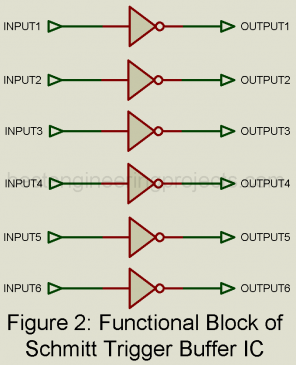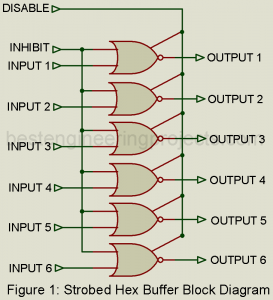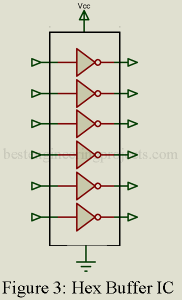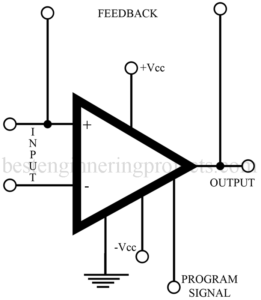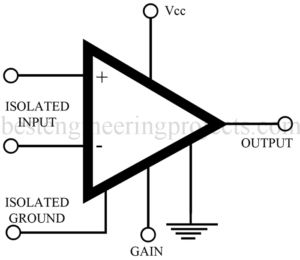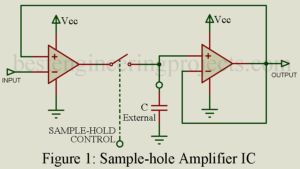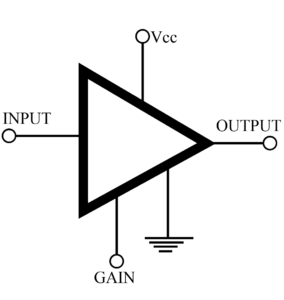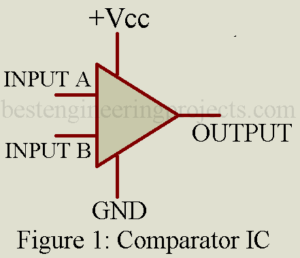In this article we see complete details about Schmitt Trigger Buffer IC. We will also see key parameters and its application. Description of Schmitt Trigger Buffer or Inverter IC | SN7414 This IC, containing six identical circuits, provides the Schmitt Trigger function and acts as buffer or inverter, as illustrated in the logic diagram if Figure 1. It is particular useful where slowly changing waveforms, such as sine waves, must be squared up, or where noise immunity must be improved. The Schmitt-Triggered circuit conducts over only a narrow “window,” a…
Read MoreCategory: Electronics Design
Strobed Buffer or Inverter IC | CD4502
In this article, we will learn about strobed buffer or Inverter IC CD4502, its parameter, truth table and its application. Description of Strobed Buffer or Inverter IC This IC provides the basic buffer or inverter function as well as two additional control functions. As illustrated in figure 1, all six inputs are controlled by a single “inhibit” signal, and all six outputs are controlled by a single “disable” signal. This permits each of the six inputs and outputs to have a total of three possible states, as indicated by the…
Read MoreBuffer or Inverter IC
In this article we will discuss about buffer or inverter IC, its key parameters, internal circuit and applications. Description of Buffer or Inverter IC The buffer or inverter is one of the key functions used in all digital logic assemblies. As the name implies, this circuit provides a stage of buffering, separation in impedance, between other logic elements of buffering, separation in impedance, between other logic elements and, when it acts as inverter, changes the input signal into its complement. While buffer or inverters are most frequently used in combination…
Read MoreLinear Follower (Current) operational Amplifier
In the Article Linear Follower Amplifier we are going to discuss about current amplifier, its parameter, applications and comment. Current amplifiers are basically Class A Amplifier which usually have a voltage gain of 1 and effectively act as impedance transformers. Their main feature is their ability to develop a substantial output current. Sometimes they are called “linear followers,” similar to emitter follower transistor circuits. Current amplifiers are often used in series with an operational amplifier, inside the feedback loop, to provide additional output current. Key parameters of linear follower amplifier…
Read MoreProgrammable Operational Amplifier
In this article we will discuss about programmable operational amplifier IC, its key parameters, applications, parts number and comments. Programmable Operational Amplifier Description Some general-purpose op amps are available with an external tab that can be connected to a “set” or programmable current. This external terminal can control such important parameters as the power dissipation, bandwidth, slew rate, output current, input impedance, and input noise. While the programming current controls some of these parameters, other parameters will remain fixed. Externally supplied programming current can be in the form of a…
Read MoreIsolation Amplifier
In this article we will discuss about Isolation amplifier, its key parameters, applications and comments. So let’s start with description. Isolation Amplifier Description: Consisting of several stages of amplification, the input amplifier is either electrically or optically isolated from the output. The input amplifier is usually a differential amplifier, the output of which is RF modulated and then transferred through an RF transformer to the second stage, where it is demodulated and filtered. The DC power supply for the input amplifier section must also be isolated so that there is…
Read MoreSample and Hold Amplifier IC
In this article, we will discuss about Sample and Hold Amplifier IC, its key parameters and its applications. But before that, let us see what a sample and hold circuit is. The principle underlying the digital signal processing is that of sampling the analog signal. Sampling basically means obtaining the discrete time signals from the reduction of the continuous time signals. The Nyquist–Shannon sampling theorem is one of the well-known and commonly used sampling theorem in signal processing. A sample and hold circuit obtains samples of an analog signal and…
Read MoreClass B, C and AB Amplifier IC
In this article we will see details like key parameters , applications and parts number of Class B, Class C and Class AB amplifier IC. Description of Class B Amplifier: In this type of amplifier, the quiescent (Q) point is set exactly at the cutoff of the IC curve, resulting in amplification of only one half-cycle of the input sinewave. Class B amplifiers are invariably connected back to back in push-pull circuits. In this arrangement one amplifier is operating during the positive cycle of the sinewave and is cut off…
Read MoreComparator IC | Parameters and Applications
In this article we all learn about comparator IC, it’s key parameter, applications and comments. So let’s first start with what is comparator IC or it’s description Description of Compartor IC Essentially a very fast-acting high-gain differential amplifier, a comparator senses the difference between two voltages and, by rapid amplification, provides maximum output immediately. De-signed for low-input current, most comparators are essentially voltage devices that interface with digital logic circuits. The various types of comparators differ primarily in the emphasis of some key parameters, such as low power consumption, fast…
Read MoreAnti-logarithmic Amplifier IC
In the Anti-logarithmic Amplifier IC the output voltage is proportional to the log or to the exponential function (antilog) of the input signal. Most logarithmic amplifier ICs are available with an external strapping option that makes them operable in either the algorithmic or the exponential (antilog) mode, as indicator in figure 1. The antilog element consists of semiconductors stage in which the input voltage procedures a current that is an exponential function. To produce a logarithmic output, the antilog element is connected as part of the feedback circuit as shown…
Read More